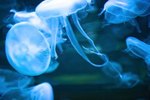Commonly called lamp shells, brachiopods look like small mollusks, although they aren't related. These ancient ocean creatures are the only members of the phylum Brachiopoda, which dates back to the Paleozoic era. They have a rich fossil history and some species that exist today are considered living fossils because they have remained unchanged after millions of years.
Structure
Adult brachiopods are between 0.2 and 2 inches long. Their bodies are enclosed between two shells, called valves, and they resemble clams. The two valves are held together at one end by muscles. Their two feeding structures, called lophophore, take up the front two-thirds of the cavity between the valves. These cilia-lined, tentacle-like structures create water currents from which they capture microplankton and organic particles. The back third of the cavity is filled with body organs and muscles. Most brachiopods attach themselves to the substrate on the ocean floor with a stemlike structure, called a pedicle, that projects from a hole near the hinge of the shell.
Classes
The two classes of brachiopods are distinguished by the way the two shells fit together and the mechanism for opening and closing them. Articulated brachiopods (class Articulata) have hinges with toothed grooves at the rear of their valves. They open their shell to feed using the dictator muscles attached to the hinge, and close the shell for protection when at rest. Unarticulated brachiopods (class Inarticulata) have no hinge and rely on hydrostatic pressure to open and close the valves.
Habitat
All brachiopods are marine animals that may inhabit sea beds or shallow areas, such as rock pools, intertidal zones and estuaries of antarctic waters. The typical brachiopod attaches himself to hard substrates or coarse sediment in protected areas, such as crevices and the undersides of boulders.They usually live in dense groups.
Life Cycle
Lamp shells live three to 30 years or more. They begin their life swimming and floating among the plankton. The larvae of articulate species float for a few days, living on yolk. When they are heavy enough, they settle to the bottom and begin a metamorphosis that changes them into adult lamp shells. Inarticulate larvae look like tiny adults and have no need of metamorphosis. They feed on microscopic organisms for months before settling to the bottom.
References
Resources
Writer Bio
Jackie Carroll has been a freelance writer since 1995. Her home-and-garden and nature articles have appeared in "Birds & Blooms" and "Alamance Today." She holds a Bachelor of Science in medical technology from the University of North Carolina.





